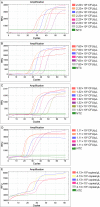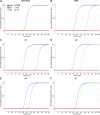Rapid and simultaneous detection of multiple pathogens in the lower reproductive tract during pregnancy based on loop-mediated isothermal amplification-microfluidic chip
- PMID: 36309654
- PMCID: PMC9616700
- DOI: 10.1186/s12866-022-02657-0
Rapid and simultaneous detection of multiple pathogens in the lower reproductive tract during pregnancy based on loop-mediated isothermal amplification-microfluidic chip
Abstract
Background: Female reproductive tract infection (RTI) is the common source of varied diseases, especially as an important risk factor for pregnancy outcomes, therefore the rapid, accurate and simultaneous detection of multiple pathogens is in urgent need for assisting the diagnosis and treatment of RTI in pregnant women. Streptococcus agalactiae (S. agalactiae), Enterococcus faecalis (E. faecalis), Gardnerella vaginalis (G. vaginalis), Candida albicans (C. albicans) and Chlamydia trachomatis (C. trachomatis) are five main pathogens in lower genital tract with high risk, serious consequences and clinical demands. The combination of loop-mediated isothermal amplification (LAMP) and microfluidic technology was used to develop the LAMP-microfluidic chip for rapid, simple, sensitive and simultaneous detection of the five target pathogens above.
Results: Standard strains and clinical isolates were used for the establishment of the novel LAMP method in tube and LAMP-microfluidic chip, followed by the chip detection on 103 clinical samples and PCR verification partially. The sensitivities of LAMP of S. agalactiae, E. faecalis, G. vaginalis, and C. albicans in tube were 22.0, 76.0, 13.2, 1.11 CFU/μL, respectively, and C. trachomatis was 41.3 copies/μL; on LAMP-microfluidic chip they were 260, 154, 3.9 and 7.53 CFU/μL, respectively, and C. trachomatis was 120 copies/μL. The positive coincidence rates of clinical stains in tube and on chip experiments were 100%. Compared with the classic culture method performed in hospitals, the positive coincidence rate of the 103 clinical samples detected by LAMP-microfluidic chip were 100%. For the six inconsistent ones, including four G. vaginalis and two C. albicans positive samples tested by LAMP-microfluidic chip and verified by PCR were negative by culturing method in hospitals, indicating the lack of efficient detection by the classic culturing method.
Conclusion: Our study suggested that the LAMP-microfluidic chips could simultaneously, efficiently, and accurately detect multiple main pathogens, including S. agalactiae, E. faecalis, G. vaginalis, C. albicans and C. trachomatis, in clinical samples of female RTI to give a great clinical value. Accordingly, this novel method has the potential to provide a valuable reference for female RTI screening and early diagnosis during pregnancy.
Keywords: LAMP-microfluidic chip; Loop-mediated isothermal amplification; Microfluidic technology; Pathogen; Rapid and simultaneous detection; Reproductive tract infection.
© 2022. The Author(s).
Conflict of interest statement
The authors declare that they have no competing interests.
Figures





Similar articles
-
Comparative analysis of loop-mediated isothermal amplification combined with microfluidic chip technology and q-PCR in the detection of clinical infectious pathogens.J Clin Lab Anal. 2022 Aug;36(8):e24565. doi: 10.1002/jcla.24565. Epub 2022 Jun 26. J Clin Lab Anal. 2022. PMID: 35754145 Free PMC article.
-
Rapid detection of multiple pathogens by the combined loop-mediated isothermal amplification technology and microfluidic chip technology.Ann Palliat Med. 2021 Oct;10(10):11053-11066. doi: 10.21037/apm-21-2792. Ann Palliat Med. 2021. PMID: 34763467
-
Quantitative and specific detection of viable pathogens on a portable microfluidic chip system by combining improved propidium monoazide (PMAxx) and loop-mediated isothermal amplification (LAMP).Anal Methods. 2021 Aug 28;13(32):3569-3576. doi: 10.1039/d1ay00953b. Epub 2021 Jul 21. Anal Methods. 2021. PMID: 34286728
-
Loop-mediated isothermal amplification-based microfluidic chip for pathogen detection.Crit Rev Food Sci Nutr. 2020;60(2):201-224. doi: 10.1080/10408398.2018.1518897. Epub 2018 Dec 20. Crit Rev Food Sci Nutr. 2020. PMID: 30569743 Review.
-
Loop-Mediated Isothermal Amplification (LAMP) for the Diagnosis of Sexually Transmitted Infections: A Review.Microb Biotechnol. 2025 May;18(5):e70153. doi: 10.1111/1751-7915.70153. Microb Biotechnol. 2025. PMID: 40317856 Free PMC article. Review.
Cited by
-
Development and optimization of a new competitive ELISA using recombinant (rPSA D15 and rCag11) antigens for the detection of Helicobacter pylori infection.PLoS One. 2025 Jan 15;20(1):e0317227. doi: 10.1371/journal.pone.0317227. eCollection 2025. PLoS One. 2025. PMID: 39813278 Free PMC article.
-
Field-Applicable Loop-Mediated Isothermal Amplification for the Detection of Seven Common Human Papillomavirus Subtypes.Trop Med Infect Dis. 2024 Oct 12;9(10):240. doi: 10.3390/tropicalmed9100240. Trop Med Infect Dis. 2024. PMID: 39453267 Free PMC article.
-
Parallel detection of multiple zoonotic parasites using a real-time fluorogenic loop-mediated isothermal amplification-based quadruple-sample microfluidic chip.Front Microbiol. 2023 Sep 26;14:1238376. doi: 10.3389/fmicb.2023.1238376. eCollection 2023. Front Microbiol. 2023. PMID: 37822745 Free PMC article.
-
The Potential Clinical Applications of a Microfluidic Lab-on-a-Chip for the Identification and Antibiotic Susceptibility Testing of Enterococcus faecalis-Associated Endodontic Infections: A Systematic Review.Dent J (Basel). 2023 Dec 26;12(1):5. doi: 10.3390/dj12010005. Dent J (Basel). 2023. PMID: 38248213 Free PMC article. Review.
-
Multiplexing LAMP Assays: A Methodological Review and Diagnostic Application.Int J Mol Sci. 2024 Jun 9;25(12):6374. doi: 10.3390/ijms25126374. Int J Mol Sci. 2024. PMID: 38928080 Free PMC article. Review.
References
-
- Qie M, Deng Y. Status and analysis of female reproductive tract infections (in Chinese). Chin J Women and Child Clin Med. 2009;5(02):102–5. 10.3969/j.issn.1673-5250.2009.02.001.
-
- Liao Q, Zhang D. Current status and research progress of diagnosis and treatment of female reproductive tract infections in China (in Chinese). International J Obstet Gynecol. 2011;38(06):469–71, 74. 10.3969/j.issn.1674-1870.2011.06.001.
-
- Wiesenfeld HC. Screening for Chlamydia trachomatis Infections in Women. N Engl J Med. 2017;376(8):765–73. 10.1056/NEJMcp1412935. - PubMed
-
- Tzialla C, Borghesi A, Garofoli F, Bollani L, Longo S, Stronati M. Prevention of early onset group B streptococcal disease: controversial issues. J Matern Fetal Neonatal Med. 2009;22 Suppl 3:38-42. 10.1080/14767050903211521. - PubMed
Publication types
MeSH terms
Supplementary concepts
LinkOut - more resources
Full Text Sources
Molecular Biology Databases

